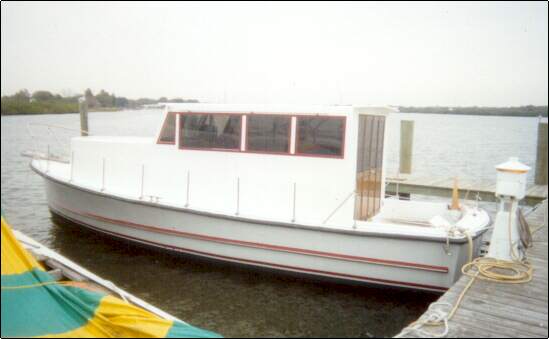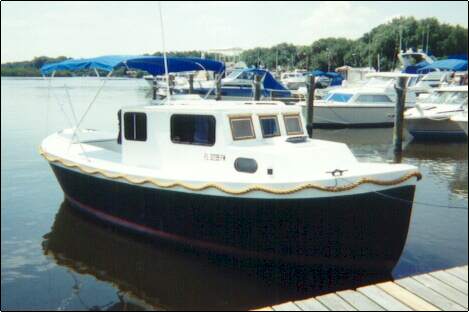| Want to build a boat? Just have to build a boat? A bigger boat with
room for the whole clan? I can sympathize. Some of us can’t help
ourselves. Nevertheless, my advice is not to build a big boat, or rather
my advice is don’t build all of it. There are two problems with large
projects, time and cost. For example, I just read a note from a fellow who
actually finished a 30 foot power cruiser. What a job he did! It’s a real
beauty, quite an accomplishment. But that’s the problem; it’s quite an
accomplishment. Took him 4000 hours, and $65,000. Even if you’ve got the
loot…be honest now…have you got the energy?
But there is an alternative. Why not buy the hull, and convert it
into the boat you want? For the bigger project, starting with the hull
already done is a much more practical proposition, especially if you’ll be
working mostly alone. Here’s a photo of a boat conversion that’s been done
right. This boat is berthed at a marina near Tampa. She’s a 40 footer, and
the owners, who live aboard, have done a really pretty job. Look at that
pretty sheer, that dark hull, and the angles on the stainless railing!
Somebody’s got a good eye.

Converted Ex-Navy “Utility
Boat”
Here’s my buddy Vernon’s boat. Like the boat shown above, Vernon’s
boat used to be in the navy. “Utility boats” they call them. Vernon bought
the hull right here in Tampa. He managed to buy it without an engine (he
had one stashed away in his shed) and he’s invested roughly the same money
and time in his project that I have in mine. Vernon’s boat is a 32 footer.
The motor is a 130 hp diesel. She’s not ready for speed trials quite yet,
but I’m taking bets she’ll do 12 knots or more. Utility boats are built
tough. All the ones I’ve seen are fiberglass, and it’s thick. Vernon’s
boat will be able take a pounding. Just the boat for thumping around the
Gulf chasing fish.

Vernon’s Boat - A Work in
Progress
My first converted boat, the General Brock, was an ex-navy lifeboat,
and he was one tough little boat. The motor was a 4-107 Perkins diesel.
That’s about 40 horse, more power than usual in lifeboats. The previous
owner said he saw him looking forlorn on the hard at a navy auction. He
bid $300, and to his surprise he had a boat! Nobody else bid. He was a
good carpenter, and he did a nice job on the cabin and decks. The General
was a heck of a good sea boat, at least he was in the chop that I had him
in. A half ton of lead bolted to his keel and a way to fasten down the
hatches would have made him even better.

The General Brock – A
Converted 24 foot Steel Lifeboat
This picture shows my current boat, the Icebreaker Danielle, making
her rather unusual exit from the yard where I did most of the carpentry
and painting. We almost dropped her doing this, but we couldn’t get the
Travel-Lift under the trees, so we had to use the fork-lift. I/B Danielle
was originally a 28 foot fiberglass lifeboat, but now she’s a low-powered
diesel cruiser. I bought the hull up in Maryland. The story goes that she
was purchased as part of the equipment needed to refit a bulk carrier. On
the way to the yard, the ship ran aground and was declared a total loss,
so the lifeboat became surplus.

An Unusual Exit
(Actually there’s a second rather boring version of this story,
wherein the ship was sold before refit, and the new owners just made other
plans. But let’s go with the first version.) Anyway, the lifeboat sat
neglected on the hard for a dozen years. Then a fellow bought her to
convert her. He got as far as ripping out the thwarts and installing an
engine. Then he gave up and she sat for another dozen, until I bought her
two years ago for $2500. The hull was light enough to pull down to Florida
behind my old car. 500 hours work, 1000 hours shmoozing, and $16,000
later, and she’s about done. If I’d had the sense to keep her simple, and
the patience to fuss with her engine longer, and done a lot less
schmoozing and more scrounging, I could have done the job for 400 hours
and maybe $8,000. Now that’s a fair number of bongo-bucks in my book, and
400 hours of prime time is long enough to make you wonder why you’re doing
it after a while. But it’s not impossible to manage for a lot of folks
over a two year period.
I/B Danielle has an 18 hp diesel, and she cruises at 6.2 knots,
burning 2/3 gallon of oil per hour. The Resident Love Goddess and I hope
to be able to take long cruises on sheltered waters on her, cruises
lasting a few months. So I made her comfortable, not sleek for sure, but
practical. The saloon has a table and a futon that makes into a double
berth. There’s a proper galley with a profane fridge. The head has a
separate shower stall, and there’s a big hold below for storage. To get
all that on a 28 foot boat, I sort of made the cabin kind of a little bit
high. Well OK then…it’s really high. I’m getting a bit touchy about it.
No, she’s not tippy. In fact she’s pretty steady on her feet. Two thousand
pounds of steel ballast in the bilge did that trick. As for the looks, to
offset the ridiculously high cabin, I tried to make her look
old-fashioned. And that works pretty well, except kids call me Popeye.
Keeps me from getting proud, I guess.

The Icebreaker Danielle
I suppose a fellow could start with practically any sort of hull,
although I do suggest it be fiberglass. It’s just all round easier to
modify, easier to keep. You can add mahogany rails and carvings if you’re
a wooden boat kind of guy. And you’ll likely make the cabin out of wood
anyway. Maybe you can find a boat that’s suffered fire damage to her
superstructure, or one that actually made it under that swing bridge, when
the train was crossing the river. Kerrunch, ka-chunk, ka-chunk...All of
which reminds me of my drinking uncle, Shipmates. Old fast-driving,
quick-diving Jean-Claude. He had a real talent for making convertibles out
of sedans. Unfortunately he did it by broadsiding tractor-trailers…But
getting back on track here, the key points are that the hull should be
inexpensive, and it should be applicable to the kind of boat you want to
build. Three types of boats with suitable hulls that I know are available
on a regular basis, at least here in the USA, are lifeboats, ex-navy
utility boats, and ex-navy motor whaleboats. All three are commonly
fiberglass. And they are open boats, so there is less to gut out before
you start building.
Lifeboats are usually 24 to 30 feet, but I have seen a used 44
footer for sale. What a yacht that one would have made! A lifeboat hull is
made to take a whole bunch of scared passengers. Capacity is the name of
the game, not speed, although I heard once that every motor lifeboat has
to be able to make 6 knots under her own power, so you’ll get that speed
anyway. Most motor lifeboats are happy with 10 to 20 horsepower. They’re
usually apple-cheeked, strong-sheered, and pointy both ends. Just the hull
for a salty gaff-rigged double-ender, if you can get a keel under her. Or
maybe a leeboard cat ketch, or a slow power cruiser like mine.

Lifeboats are unusual in that they aren’t made to spend their lives
in the water. They only have to live on deck. So some of them are lightly
built, or they’ll have quirky details that need correcting for continual
service afloat. Maybe the rudder is so ugly it keeps you awake at night,
or the bottom could use a couple more ribs. Not to worry, they’re usually
easy to beef up on the inside with wood and epoxy/glass cloth, and epoxy
coatings can seal most any hull very well indeed. For example, the General
Brock was galvanized steel. The hull was plenty strong, but believe it or
not the seams in the hull were lapped and riveted. I guess that’s all
right for a boat that swings under a ship’s davits, but immersed in salt
water all the time, it just has to rust. A couple coats of coal tar epoxy
and a mechanical shaft seal solved that problem in a hurry. Mechanical
shaft seals are the best thing to happen to small inboard boats since the
CQR anchor.

Oooo! Just Can’t Abide that
Ugly Rudder!
Ex navy utility boats have a round bottom with a long run. I suppose
that’s a semi-planing hull, but the ones I’ve seen look like they wouldn’t
make a lot of fuss at displacement speeds. So they would be a better
choice for a larger or faster power cruiser, or maybe a “trawler” type
pleasure boat. They have the most wonderful rubrails, solid rubber about 4
inches thick. If there’s anything on a boat that will make you happy
around marinas and docks it’s a 4 inch thick solid black rubber rubrail.
You’ll find ex-navy utility boats from 32 foot on up to 50 foot, and there
are lots of them for sale at very good prices, say $5000 up to $20,000 for
a really big one.

Ex-navy whaleboats, like this one, have the same super rubrails,
same sailors I guess. They’re built to be the ultimate open boats for
rough water. Their cockpits are self-bailing, and their hulls are narrow.
They all seem to be around 26 foot. They all seem to look the same too.
Their engines tend to be somewhat larger, about 70 hp with a man-sized
prop. A whaleboat is kind of narrow for a pleasure cruiser. To me, they’re
all begging to be turned into lunch bucket tugs. You can get one in pretty
good shape for maybe $6500. Deck over the cockpit, and cut in some hatches
for stowage. Build a pilothouse on top of the deck, good and high for
visibility. Give the engine a going over, bung a bit of ballast below and
Bob’s your uncle. Then you need a low house barge, with a gangplank and a
motorsooter. Flower pots, flagstaffs and wooden barrels, and room to keep
the Missus and her hobbies in style. Take up whittlin’, fishin’ and
storytellin’, and you can spend years tootling up and down canals and
rivers and along the coast.
You can find your hull in “Boats and Harbors” or on the net at
www.boattraderonline.com
Search under the keyword “lifeboat” or “ex-navy” or “utility boat”. I
bought my two lifeboats that way.

“There’s one! Under that tree.
And it looks like they’ve given up on her.”
So that’s my case, Shipmates. It’s sacrilege I know, but maybe you
shouldn’t build the hull, especially if you’ve got a bigger project in
mind. You can save a noble old boat from the scrap heap and scratch that
boat building itch at the same time. You’ll get as much or more boat for
the buck. You’ll be done sooner.

“It’s a drake-tailed steam
launch in disguise.
Try a hundred bucks on them. Naw…better make it fifty.”
|